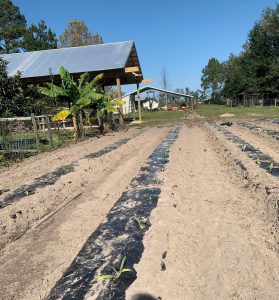Jay Capasso – UF/IFAS Columbia County Extension, Shinsuke Agehara – UF/IFAS Gulf Coast Research and Education Center, Prissy Fletcher – UF/IFAS St. Johns County Extension.
Introduction:
Globe artichoke (Cynara cardunculus L) is an emerging crop for Florida agriculture. In the United States, about 99% of artichokes are produced in California in the central coast and southern regions. Originating from the Mediterranean region, artichokes prefer climates where summers are dry, winters are mild/moist, and temperatures range between 45°F to 85°F. To initiate bud development, artichokes require 250-500 hours of exposure to temperatures below 50°F (chilling degree). However, gibberellic acid, a plant hormone, can be applied to induce bud development in climates lacking sufficient chilling degree hours. Artichokes can tolerate light freezes, but become damaged when temperatures fall below 28°F.
Dr. Shinsuke Agehara, Assistant Professor of Horticulture at the University of Florida, has conducted research on artichokes at the UF/IFAS Gulf Coast Research and Education Center. This year Dr. Shinsuke Agehara provided artichoke transplants to a Columbia County grower in the Lake City area to conduct an on-farm trial. The on-farm trial is a collaboration between the grower and UF/IFAS Columbia County Extension. There is interest in whether the increased chilling degree hours in North Florida could result in increased artichoke quality and yield in comparison to the Gulf Coast Research and Education center, located further south in the greater Tampa area. Artichokes are also being evaluated in North Florida at the Hastings Agricultural Extension Center.
Artichoke Row Spacing/Planting:
Recommended row spacing is about 5-6 ft and plants are spaced 3 ft apart, generally on plastic.
Artichoke Nutrient Management:
Based on research conducted by Dr. Agehara, 200-250 lbs of nitrogen (N) per acre are needed for maximum yield potential. About 50 lbs N can be applied in furrow with additional applications applied through fertigation up to 2 lbs per day. Soils should be tested to determine phosphorus (P) and potassium (K) inputs. Additions of P and K are not needed when soils test above 60 parts per million (ppm) P and 120 ppm K. Calcium, generally in a liquid fertilizer form, should also be applied. Artichokes deficient in calcium can become susceptible to blossom end rot disease.
Planting:
Due to Florida’s hot humid summers, annual production of artichokes is recommended between mid-October and April. Generally, transplants are used at planting. Seedlings can be grown in 128-cell polystyrene trays. Seedlings should mature for 6-7 weeks and reach a height of 5-6 inches with 4-5 leaves prior to planting. Avoid planting transplants too deep because the delicate shoot meristems located at the base of the leaves can be easily damaged. For annual production artichoke transplants should be planted prior to November 15th for optimal climatic conditions.

Gibberelic acid:
Gibberelic acid should be applied to artichoke plants in Florida because the climate does not satisfy the necessary chilling degree requirements to induce bud formation. Commercial formulations of gibberellic acid registered for artichokes include ProGibb LV and GibGROW 4LS. Two applications of gibberellic acid are recommended. The first application occurs around 6 weeks after planting transplants (or after 7-8 leaves emerge) and the second 2 weeks after the first application. It is important to apply gibberellic acid at the right time to ensure optimal bud formation and harvest timing. Gibberellic acid cost about $15-20 per acre.
Harvest:
Artichokes are a 90-day crop after planting. The globes are hand harvested and cut about 3-4 inches below the base of the bud. Plants will produce multiple secondary heads soon after the primary head is harvested. The primary and secondary heads are marketable as fresh market artichokes.
Insect Control:
Insects found to attack artichokes in Florida include aphids, spider mite, stink bugs, and flea bugs. Aphids and spider mites may require chemical treatment.
Plant Disease:
Diseases pythium, ramularia leaf spot, and blossom end rot are prevalent in Florida artichokes. Ridomil can be applied around planting time to protect against pythium. Quadris top can be applied for ramularia leaf spot protection. Calcium foliar spray can be used to prevent blossom end rot. Common diseases observed in California artichoke production include artichoke curly dwarf, bacterial crown rot, damping-off, gray mold (botrytis rot), powdery mildew, and verticillium wilt. These diseases have not yet been found to cause severe damage in Florida artichoke production.
For more information:
See link to EDIS Article on Artichoke Production Guidelines: https://edis.ifas.ufl.edu/hs1289
The commercial products listed are possible recommendations to help manage plant diseases or induce bud development in Florida artichoke production. This blog post is intended for educational purposes. It is not the intention of the authors to provide a complete list of product recommendations or endorse a particular product or brand.
 0
0
